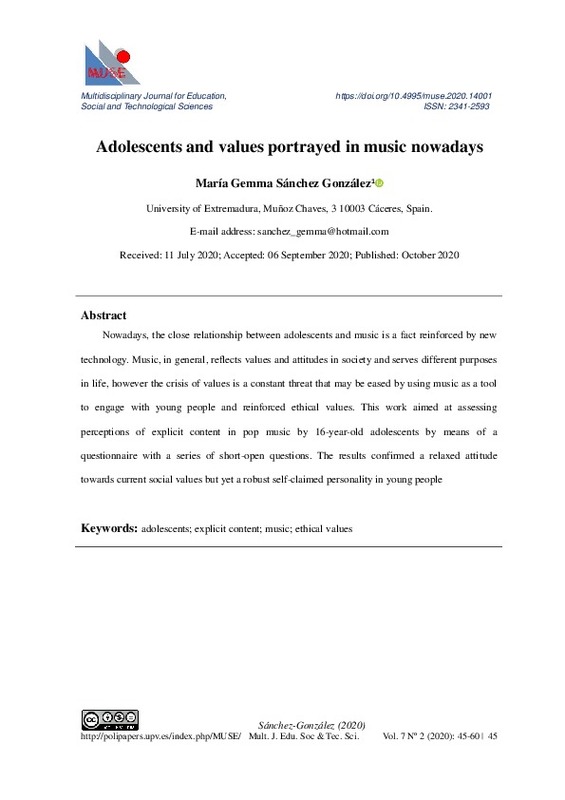Abbott, M (2002). Using Music to Promote L2 Learning among Adult Learners. TESOL Journal11,1 (2002): 10-17.
Amuthavalli, T., & Sridevi, M. (2014). A study of the value orientation of degree college students. MIER Journal of Educational Studies, Trends & Practices, Jammu: Model Institute of Education & Research, v. 4, n. 2, p. 262-271.
Aubrey, J. S. (2006). Effects of sexually objectifying media on self-objectification and body surveillance in undergraduates: Results of a two-year panel study. Journal of Communication,56,pp.366-386. https://doi.org/10.1111/j.1460-2466.2006.00024.x
[+]
Abbott, M (2002). Using Music to Promote L2 Learning among Adult Learners. TESOL Journal11,1 (2002): 10-17.
Amuthavalli, T., & Sridevi, M. (2014). A study of the value orientation of degree college students. MIER Journal of Educational Studies, Trends & Practices, Jammu: Model Institute of Education & Research, v. 4, n. 2, p. 262-271.
Aubrey, J. S. (2006). Effects of sexually objectifying media on self-objectification and body surveillance in undergraduates: Results of a two-year panel study. Journal of Communication,56,pp.366-386. https://doi.org/10.1111/j.1460-2466.2006.00024.x
Babtrakinova O.I., Voloshko A.A., & Snistaryova P.A. (2017). Influence of modern music on young generation. Human and society, 2(3), 4-6.
https://doi.org/10.21661/r-462119
Bauman, Z. (1998). Globalization, The human consequences. Columbia University Press;
Bogt, T., Mulder, J., Raaijmakers, Q., & Gabhainn, S. (2010). Moved by music: A typology of music listeners. Psychology of Music. https://doi.org/10.1177/0305735610370223
Coyne, S., Stockdale, L., Nelson, D., & Fraser, A. (2011). Profanity in Media Associated With Attitudes and Behavior Regarding Profanity Use and Aggression. Pediatrics. https://doi.org/10.1542/peds.2011-1062
Creswell, J. W., & Clark, V. L. P. (2017). Designing and conducting mixed methods research. London: Sage Publications
Christenson, P. G., de Haan-Rietdijk, S., Roberts, D. F., & ter Bogt, T. F. M. (2019). What has America been singing about? Trends in themes in the U.S. top-40 songs: 1960-2010. Psychology of Music, 47(2), 194-212. https://doi.org/10.1177/0305735617748205
DeWall, C. N., Pond, R. S., Jr., Campbell, W. K., & Twenge, J. M. (2011). Tuning in to psychological change: Linguistic markers of psychological traits and emotions over time in popular U.S. song lyrics. Psychology of Aesthetics, Creativity, and the Arts, 5(3),200-207. https://doi.org/10.1037/a0023195
Fonseca-Mora, M.C.; Toscano-Fuentes, C.,& Wermke, K. (2011). Melodies that help: The Relation between Language Aptitude and Musical Intelligence. Anglistik International Journal of English Studies.22(1):101-118.
Fouce, H.(2010) De la crisis del mercado discográfico a las nuevas prácticas de escucha.Comunicar (34). pp. 65-72. ISSN 1134-3478.
Glass, G.V., & Stanley, J.C. (1980). Métodos estadísticos aplicados a las ciencias sociales. Barcelona:Editorial Prentice/Hall Internacional
Hall, P., West, J. H. C., & Hill, S. (2012). Sexualization in lyrics of popular music from 1959 to 2009: Implications for sexuality educators. Sexuality & Culture:An Interdisciplinary Quarterly,16, pp.103-117. https://doi.org/10.1007/s12119-011-9103-4
Ilisko, D. & Kravale-Paulina, M. (2015). Sustainability of Family Values Through the Generation as Viewed by the Bachelor Program Students. Society, Integration, Education. Proceedings of the International Scientific Conference. https://doi.org/10.17770/sie2013vol1.154
Juslin, P. N., Liljeström, S., Västfjäll, D., & Lundqvist, L.-O.(2010). How does music evoke emotions? Exploring the underlying mechanisms. In P. N. Juslin & J. A. Sloboda(Eds.), Series in affective science. Handbook of musi.c and emotion: Theory, research, applications(p. 605-642). Oxford University Press. https://doi.org/10.1093/acprof:oso/9780199230143.003.0022
Knobloch-Westerwick, S., Musto, P., & Shaw, K. (2006). Rebellion in the top music charts: defiant messages in rap/hip hop and rock music-1993-2003. Presented at: the International Communication Association Conference; Dresden, Germany.
Kumar, V. (2015). Essential principles for quality education. International Journal of Multidisciplinary Educational Research, Visakhapatnam: Sucharitha Publications, v. 4, n. 5, p. 19-29.
Laiho, S. (2002). Musiikki Nuorten Kehityksen ja Psyykkisen Itsesäätelyn Tukena, MA thesis. University of Jyväskylä, Finland.
Martino, S., Collins, R.; Elliott, M.; Strachman, A., Kanouse, D., & Berry, S. (2006). Exposure to Degrading Versus Nondegrading Music Lyrics and Sexual Behavior Among Youth. Pediatrics. https://doi.org/10.1542/peds.2006-0131
Pajaziti, A. (2014). Values and academia: a sociological-empirical approach. Revue des Sciences Politiques, Craiova: Editora Universitaria Craiova, v. 43, p. 125-140.
Papinczak, Z. & Dingle; Genevieve & Stoyanov, S.; Hides, L. & Zelenko, O. (2015). Young people's uses of music for wellbeing. Journal of Youth Studies. 18.
https://doi.org/10.1080/13676261.2015.1020935
Rentfrow, P., & Gosling, S. (2003). The Do Re Mi's of Everyday Life: The Structure and Personality Correlates of Music Preferences. Journal of personality and social psychology. https://doi.org/10.1037/0022-3514.84.6.1236
Roberts, D. F., Henriksen, L., & Foehr, U. G. (2009). Adolescence, adolescents, and media.In R. M. Lerner & L. Steinberg (Eds.), Handbook of adolescent psychology: Contextual influences on adolescent development(p. 314-344). John Wiley & Sons Inc. https://doi.org/10.1002/9780470479193.adlpsy002010
Rokeach, M. (1973). The nature of human values. New York: Free Press.
Saarikallio, S., & Erkkilä, J. (2007). The role of music in adolescents' mood regulation.Psychology of Music, 35, pp.88-109. https://doi.org/10.1177/0305735607068889
Saunders, B., Sim, J., Kingstone, T., Baker, S., Waterfield, J., Bartlam, B., & Jinks, C. (2017). Saturation in qualitative research: Exploring its conceptualization and operationalization. Quality and Quantity, 1-15. https://doi.org/10.1007/s11135-017-0574-8
Sloboda, J.A. (1992). Empirical Studiesof Emotional Response to Music, in M.R. Jones and S. Holleran (eds) Cognitive Bases of Musical Communication, pp. 33-45. Washington, DC: American Psychological Association71-104. New York: Oxford University Press. https://doi.org/10.1037/10104-003
Sortheix, F. & Parker, P,; Lechner, C. & Schwartz, S. (2017). Changes in Young Europeans' Values During the Global Financial Crisis. Social Psychological and Personality Science. https://doi.org/10.1177/1948550617732610
Tarrant, M., North, A.C., & Hargreaves, D.J. (2000). English and American adolescents' reasons for listening to music. Psychology of Music, 28, 166-173.
https://doi.org/10.1177/0305735600282005
Taruffi, L., & Koelsch, S. (2014) The Paradox of Music-Evoked Sadness: An Online Survey. PLoS ONE9(10): e110490. https://doi.org/10.1371/journal.pone.0110490
Zillmann, D., & Gan, S.-l. (1997). Musical taste in adolescence.In D. J. Hargreaves & A. C. North (Eds.), The social psychology of music(p. 161-187). Oxford UniversityPress.
Ziv, N. (2004) The Relationship between Social Circumstances and Recounted Musical Experiences, paper presented at the 8th International Conference on Music Perception and Cognition, Evanston, IL, August.
[-]








